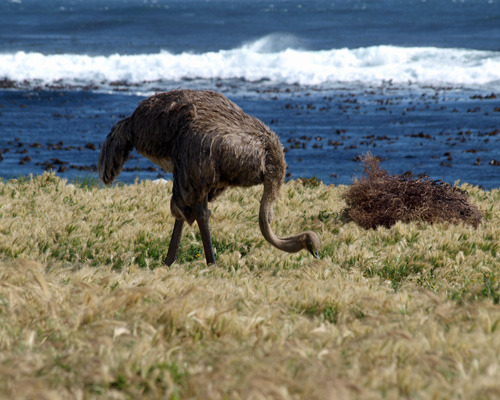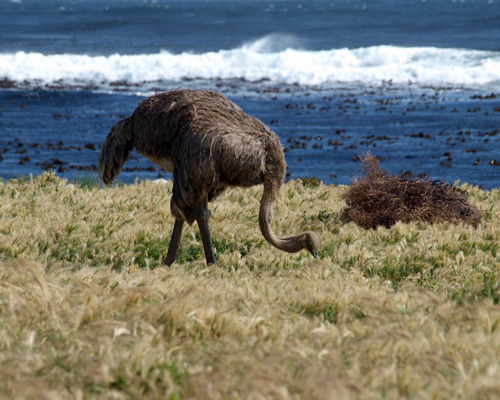Best Ostrich Recipes
Last time we brought you an exotic meat to cook, alligator, we must admit it was primarily for shock value. However, this time is the real deal: Ostrich can be, and in some ways already is, a serious contender as an alternative source of red meat. Why? Well, because not only is it a healthy source of protein, but it's delicious as well.
On the health front, the American Heart Association recommends ostrich as a source of lean meat since it is "very low in total fat, saturated fat, cholesterol, and sodium." The recommended 6-ounce serving contains just 4.8 grams total fat, 0 grams saturated fat, 162 milligrams cholesterol, and 132 milligrams sodium, according to the Academy of Nutrition and Dietetics. That's comparable to the same-size serving of skinless chicken breast, which has 6 grams total fat, 1.8 grams saturated fat, 144 milligrams cholesterol, and 126 milligrams sodium. But ostrich is far more flavorful than any skinless chicken breast, no matter how juicy and perfectly cooked.
That's because ostrich is rich in flavor, more like a red meat than any poultry. It does not taste like chicken; in fact, it tastes similar to beef. This key difference is important to understand. It is not your typical bird. The Daily Meal's video producer Ali Rosen recently had a chance to get up close and personal with some of these lovely birds during a recent trip to Cape Point, just outside of Cape Town, South Africa, where wild ostriches can be found naturally roaming by the coastline. She says that "ostriches are really scary" and that "I think the thing that's amazing [about ostriches] is that when you're next to them you realize just how powerful they are. You usually think of birds [that we eat] as really small. And when you want something like a burger, you want it to come from something meaty. But ostriches have legs as big as people's."
An ostrich, then, is not your typical bird. We've even heard them characterized them as "horse-birds," which is pretty apt considering they are raced for sport in certain parts of the world. A typical ostrich is a sturdy animal; ranging from 7 to 9 feet tall, they would tower over most people, and in fact, they are the world's largest bird. They are able to achieve a top speed of 43 miles per hour and can sprint for 31 miles before running out of steam; one stride spans anywhere between 10 to 16 feet. Ostriches weigh anywhere between 220 to 350 pounds, and can kill people with a blow from one of their powerful legs. Ostriches are found in many parts of Africa, but are also being raised in other parts of the world, including in the Middle East, where their subcutaneous oil is prized for its use in medicine and cosmetics, and their sharp claws are useful for polishing diamonds. Here in the United States, much like in the Middle East, ostrich is catching on as a popular alternative to red meat. (Photo courtesy of Daniel Gourvitch)
Ostrich is often sold as fillets, tenderloins, and roasts, as well as ground. It is versatile and can be used to make delicious burgers; just keep in mind that because it is leaner than ground beef, it will cook faster, says Misha Levin, corporate chef of Bareburger. He says that ostrich burgers are best cooked to medium at most; anything beyond that would just dry out the patty. Ostrich meat in general is a great substitute for similar cuts of beef in many dishes. Their eggs are also often sold at farmers' markets; ostrich eggs are huge and taste similar to chicken eggs.
Where can one buy ostrich meat? Well, as it turns out, there are quite a few reputable vendors that sell online. Blackwing Quality Meats, for instance, is the largest producer of ostrich meat in North America and also sells "normal meat" — i.e. chicken, beef, pork, and turkey — that is certified organic. While not cheap — ground ostrich meat will run you $13.50 per pound as of this writing, a roast will cost $13.80 per pound, and various cuts of fillet will cost anywhere between $18 to $28 per pound — they do seem to take great care in making sure meat arrives fresh at your door, usually within three days after being flash-frozen and packed with dry ice and gel packs. Their ostriches are also free-range. Their minimum order is 5 pounds, but they say ostrich meat can be refrozen without any adverse effects. Other vendors worth considering include Fossil Farms and Exotic Meats USA.
So, what are you waiting for? Go out there and chase down an ostrich. When you've come back and caught one, try one of these fantastic recipes.
Mustard-Glazed Ostrich Fillet with Berry-Marmalade Sauce
This elegant recipe from Ariane Daguin of D'Artagnan Meats is a true showstopper. (Photo courtesy of Tom Eckerle)
Licorice-Dusted Ostrich Loin with Farro and Figs
Anyone looking to impress, please apply. This is how you want to serve ostrich when the boss is over for dinner, for Valentine's Day, or for a bar mitzvah. Try this recipe from chef Rick Tramonto of Tramonto Steak & Seafood and Restaurant R'evolution. (Photo courtesy of Tramonto Steak & Seafood)
This burger is prepared simply, with just a little Worcestershire sauce, salt, and pepper for seasoning, which allows the true flavor of ostrich to shine. (Photo courtesy of Sassafras Bar)
An Asian-inspired marinade keeps these steaks nice and juicy in the smoker or on the grill. (Photo courtesy of Anna Maria de Freitas)
Will Budiaman is the Recipe Editor at The Daily Meal. Follow him on Twitter @WillBudiaman.

